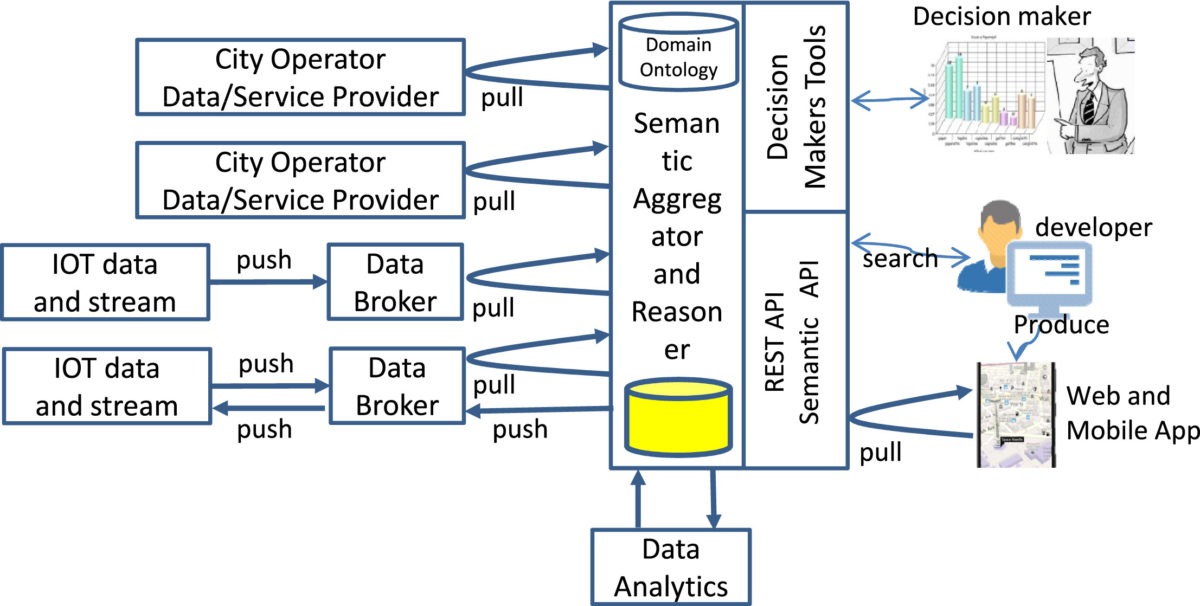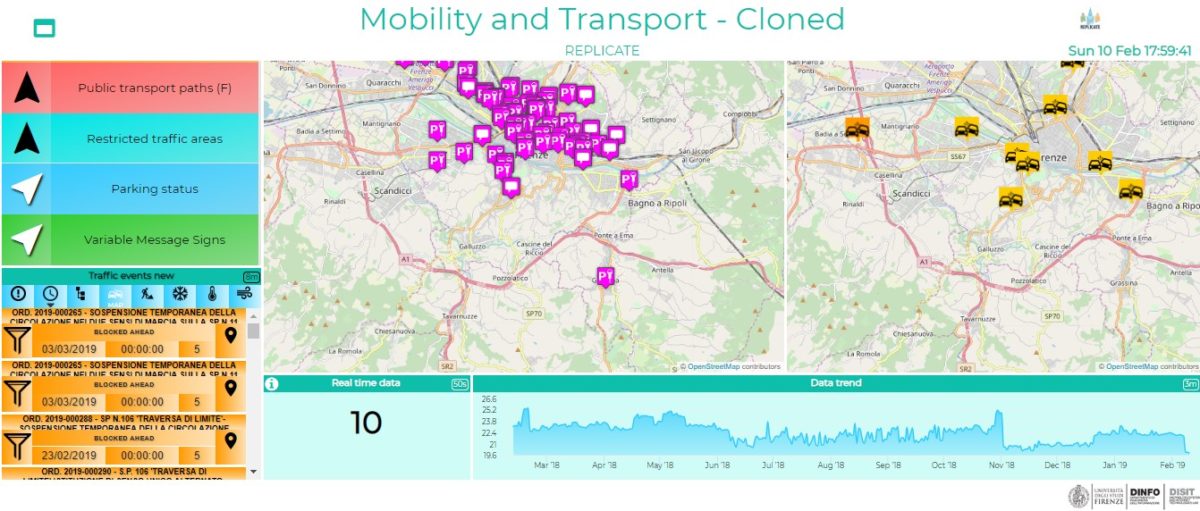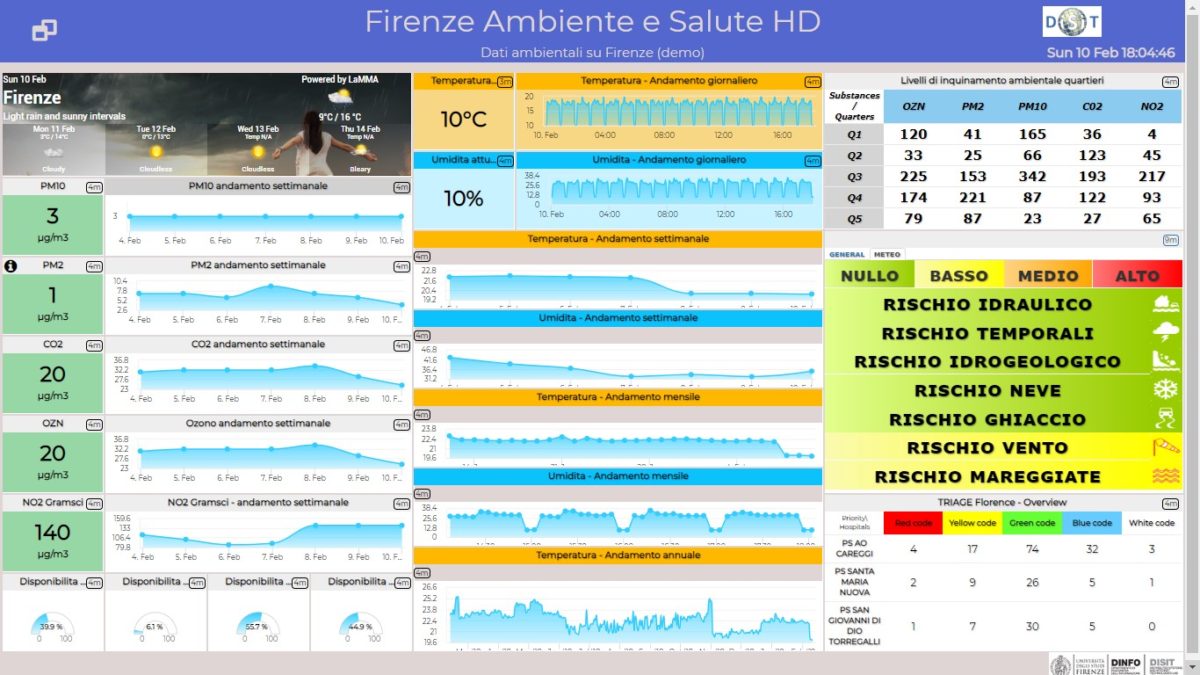
Interoperability is such a crucial term when your mind gets enlightened with your smartest idea.
You start thinking how to make it work and the more advanced and complex your project, the more you start realising that problems should be tackled one per time; hopefully someone has already produced some code that you will eagerly fagocitate to solve each of them. Even if you are lucky, the real problem remains: you have got “the vision”, the whole idea, and when you have to put all pieces together, then the risk to create a Frankenstein is much more of a probability.
Well this is basically what happens when you deal with Smart Cities: the main technical issues regarding smart city solutions are related to data access, aggregation, reasoning, access and delivering services via Smart City APIs.
A developer can use OpenData provided by municipalities, which are often static data or data provided by City Operators through some APIs as Web Services or REST calls. Yet the real power of Smart City APIs comes from the usage of real-time data that can be provided by City Operators or by end users. As a matter of fact, the data aggregator of the city may be compliant with multiple standards or, in some cases, with custom solutions such as the status of hospitals’ emergency units (triage), the status of earthquakes in the regional area, etc.
The effective deployment of smart services for city users is very frequently viable only by exploiting the semantic integration of data such as: open data, private data and real time data coming from administrations and different city operators. This implies specific processes of reconciliation and the adoption of unifying data models and ontologies.
This is what Snap4City provides to a developer. Snap4City is a platform built on top of the KM4City ontology, which is one of the most comprehensive smart city ontologies in terms of domain coverage. Km4City also addressed health (with pharmacies, hospital and real time data of first aid), environment (with pollution and pollination, in addition to weather forecast), and private mobility with fuel prices. Snap4City leverages on this capability to provide:
- Semantic Interoperable Data/Services
- API Independent from the Data model changes
- Data Visualisation (business intelligence, dashboarding)
- Decision Maker Support
Basically, Snap4City implements a Smart City Architecture (Figure 1) based on a semantic data aggregator and reasoner that enables the provision of semantic Smart City API and Decision Makers Tools. What makes the difference is the man-made ontological model among city entities and not a simple ontology generated on the basis of data tables structure.

Figure1: the Smart City Architecture behind Snap4City
This kind of Smart City Architecture is the one that responds to the requirements for handling big goals, like enhancing mobility.
Terrestrial transportation systems are more often affected by congestion situations, since specific situations cannot be easily foreseen by using traditional Intelligent Transport Systems (ITS), that only cope with transport data and mobility aspects, disregarding events, energy, weather, people flow, etc. Providing suggestions and hints on route planning, inter-modality routing, parking, hospital finding in the case of emergence, finding specific point of interests, setting predictions (for parking and traffic) and detecting anomalies for early warning surely requires not only static data but also real time data coming from users or other devices. By using the Snap4City platform, it is possible to use all those data, whether they are retrieved by push calls or if they are called in pull by the data aggregator. This allows the developer to reason on event-driven services, which can be finalised to smart purposes, like reducing the traffic jam.
Figure2: Snap4City Dashboard’s example for Mobility and Transport monitoring
Thanks to the Dashbord Builder it is also possible to set up smart city control rooms. Snap4City provides a ServiceMap which allows visually formalising queries and generating calls compliant with Km4City Smart City API. The ServiceMap development tool can be used to create mobile and web applications, like the one shown in Figure 2.
The Dashbord builder is a powerful tool, especially when we want to check multiple information with one glimpse: this is what an Health and Environment dashboard requires and can be easily arranged on a single screen (Figure 3).
Figure3: Florence’s Health and Environment Dashboard
Snap4City solution is fully open source, supports cloud and scalability for processing and IOT/IOE, respect user needs and privacy according to the different user kinds, provide tools and community for co-creation.
These properties make Snap4City a platform adoptable also by the Industry 4.0.
Especially because of its Application Builder, the tool for creating IOT Snap4City Applications. The Application Builder allows to create processes in containers, based on NodeRED App. The IOT Applications can read and act on IOT devices, exploit MicroServices, external services and the application is fully created by composing NodeRED Blocks.
Building a Datacenter Energy Consumption, by collecting on cloud massive data from all IOT devices, is the first step towards optimisation in the future industries. Nevertheless, it is still adoptable even for your small project.
The final aim of Smart City services is to support city users in a smarter and more efficient manner, stimulating their participation to the city strategies. In order to get there, we first need to collect and elaborate all kind of data we produce everyday, without putting aside privacy concerns. Snap4City aims at solving this problem and could be a milestone towards having sentient cities.
Snap4City Hack
Snap4City platforms and solutions are available at Snap4city.org website, where you can register and start exploring its features. But if you want to really challenge your skills and propose your innovative solutions for connected cities, you can join the upcoming Snap4City Hack, the big online hackathon on the topics of Smart City and IoT.
Snap4City launched a big online Hackathon on Ecological Watch, Social and Service Evolution, Stimulating Business Growth, City Aware.
Using Snap4City tools to manage IoT, Big Data and analytics, the hackathon challenges will cover different themes – Ecological Watch, Social and Service Evolution, Stimulating Business Growth, City Aware – and real data from cities such as Helsinki or Antwerp.
Further information on the Hackathon is available on the on Snap4City.org/hackathon website.

